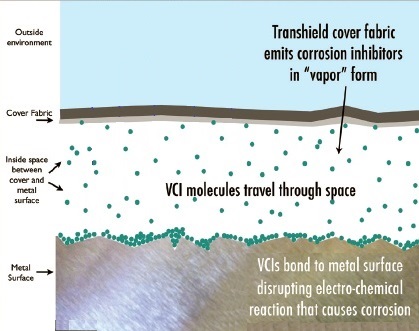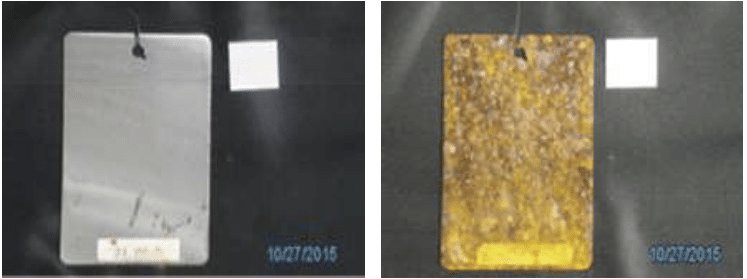Practical Solution: There is an easy to implement, preventative solution for intermodulation interference that employs chemistry: advanced protective covers made from vapor corrosion inhibitor enhanced materials.
A vapor corrosion inhibitor (VCI) is a chemical substance, or combination thereof, which prevents or significantly reduces the onset of corrosion without reacting with the environment [1]. A corrosion inhibitor may provide protection via three fundamental mechanisms [2]. They either form an ionic bond on the surface, as shown in Figure 1, form a film by oxide protection of the surface, or change the corrosiveness of an aqueous media. Sharman et al. [3] provide a detailed description of VCIs and examples of their military use.

Hienonen et al. note that VCIs neither cause a short circuit in the conductor spacing on the isolator surfaces nor form an electrically isolating film on the connector contacts and thus can be used safely in electronics [4].
The VCIs protect the asset (including connectors) from the environment [5]. The VCIs are blended to protect multiple metals and must be in sufficient quantity to last for an extended period. The blend also contains low and high vapor pressure VCIs to provide short and long-term protection. Advanced protective covers with VCI meet these needs and are tested in some of the harshest environments.
A typical test was conducted in 2015 at the request of USARPAC and the 25th Infantry Division. Transhield
ArmorDillo® advanced protective covers were placed on a MEP-1040 Generator which was then shipped from Hawaii to Australia (Phase I) and later from Malaysia to Hawaii.
Paired coupons were employed inside and outside the cover to assess the level of protection provided to the asset. Stand-alone coupons were also employed. At the end of the 35-day Phase II voyage, U.S. Army personnel witnessed the removal of Transhield’s covers. Photographs of the coupons were taken immediately. Typical paired coupon results after this voyage are shown in Figure 2. Transhield’s ArmorDillo advanced protective cover with VCI provided an average 87% protection for all coupons. A logical conclusion is that similar protection is provided to unpainted metals of the MEP-1040 Generator.
Figure 2. MEP-1040 Generator Coupons After Exposure
 ArmorDillo 98.4% Protection | No Cover 0.0% Protection
ArmorDillo 98.4% Protection | No Cover 0.0% Protection
Equipment protected by a Transhield cover with VCI results in less corrosion induced maintenance and fewer repair parts delivering a high degree of readiness.
Independent Approval: In 2013, NAVSEA approved the next generation advanced protective cover with VCI technology developed by Transhield. Made from ArmorDillo®, these second-generation covers provided a lighter, more form-fitting cover.
Bottom Line: Three fundamental components are required to protect assets:
1. Covers must be made from VCI enhanced fabric.
2. Cover design matters; covers must be formfitting.
3. Covers need to be installed correctly and secured property to protect equipment.
References
[1] Corrosion: Understanding the Basics, ASM International, Materials Park, OH 2000, pp. 401
[2] Darvina, C. G., Galio, A. F., Corrosion Inhibitors – Principles, Mechanisms and Applications, 2014,
http://www.intechopen.com/books/developments-in-corrosion-protection
[3] Sharman, D. J., Washburn, M., Ozol, S., The Wide Ranging Benefits of Corrosion Inhibitors, The Department of Defense Allied Nations Technical Corrosion Conference, August 2017
[4] Hienonen, R., Lahtinen, R., Corrosion and climatic effects in electronics. Espoo 2007, VTT Publications 626.
[5] Menke, J. T. Corrosion of VCI protected Components. 1997, NACE Corrosion 97, paper No. 541